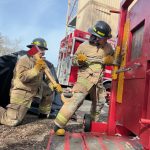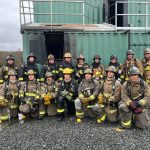
How Mendocino College is Building the Firefighting Pipeline for the Future
When people think of a firefighter, they often picture someone rushing into danger, battling flames head-on. But as Chris Dewey can attest, the role has evolved far beyond that.
A former police chief turned educator, Dewey now serves as Public Safety Coordinator at Mendocino College, where he’s helping build the next generation of firefighters in the region. Over the years, he’s seen fire departments that once relied on volunteer or seasonal crews face an urgent need for trained, year-round firefighters.
“With sprinklers, building codes, and better fire prevention, fires themselves are less common,” says Dewey. “But the reliance on fire departments to respond to everything else – traffic accidents, heart attacks, rescues, crime scenes – has grown tremendously. They’re truly first responders.”
Thanks to a grant from the Strong Workforce Program (SWP), Mendocino College was able to launch its Firefighter Academy two years ago, expanding on what had been a smaller, wildland-focused program. The academy offers a four month, 500-hour program that prepares students for firefighting careers – but one key piece was missing.
Because the program is new, it’s not yet accredited through California State Fire Training, meaning students couldn’t complete the capstone testing required to get certified and hired. At first, students had to find a capstone testing provider on their own. But in the program’s second year, the college established a Capstone testing partnership with the College of the Siskiyous in Weed, with the SWP grant covering students’ travel and lodging for three days.
“The partnership with the College of the Siskiyous has been huge,” says Dewey. “It gives us the ability to continue developing everything we need for accreditation – policy manuals, instructor resumes, safety procedures, agreements with agencies – while learning in real time. That kind of support means everything. It’s helping us build the foundation for what will one day be a fully accredited, locally run Fire Academy.”
SWP funding will also allow the academy to grow, expanding class sizes to 24 students and strengthening the pipeline of trained firefighters ready to serve the region.
 Sweat, Skill, and Service: The Path from Training to Firefighting
Sweat, Skill, and Service: The Path from Training to Firefighting
Brandon Slater is among the 18 students who have participated in Mendocino College’s Fire Academy over the past two years. After initially considering a career in law enforcement, he eventually found his calling in firefighting – and hopes to move into engineer or captain roles one day.
He describes the program as intense: “You’re up early for a morning workout, then in the classroom for about four hours, then out on the training grounds in the afternoon to apply what you learned. It’s a full day, it’s physically demanding, and you’re out there in 100-degree heat with 100 pounds of gear. It’s tough, but it’s worth it.”
The capstone testing was equally demanding. Over three days, Slater completed written and skills assessments covering structure, wildland, and HAZMAT operations. “You have to understand everything from building construction to gas and water systems to rescue operations,” he says. “You’re not just fighting fires, you’re problem-solving in all kinds of situations.”
After getting certified, Slater joined the Little Lake Fire Department as a volunteer firefighter while awaiting placement with CAL FIRE. He’s also back at the academy as a subject matter expert, helping future students prepare for the same challenges he faced.
“Now that I’ve gone through the process, I can tell the next group exactly what to expect,” he says. “Being able to share that knowledge with future firefighters is something I take a lot of pride in.”
Though the work is challenging, Slater says it comes with lifelong friendships that make every day worthwhile. “It takes a certain kind of person to become a firefighter, but once you feel that adrenaline and see the impact you can make, you realize it’s something you want to build a career around.”
November 2025